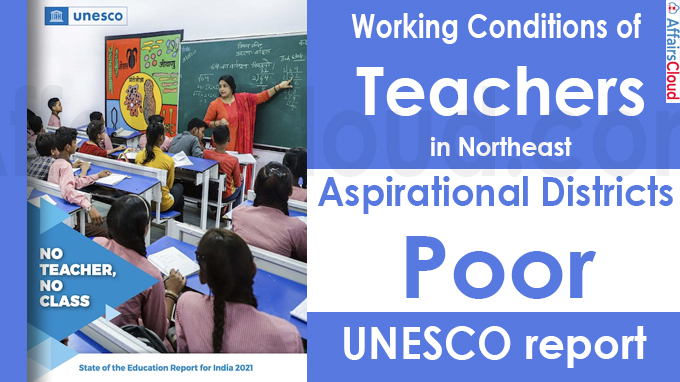 In accordance with the UNESCO (United Nations Educational, Scientific and Cultural Organization) report titled ‘The report – 2021 State of the Education Report (SOER) for India: No Teachers, No Class’, Indian teachers are facing lack of basic amenities like toilets in northeast and aspirational districts. There are disparities in their working conditions between urban and rural schools.
In accordance with the UNESCO (United Nations Educational, Scientific and Cultural Organization) report titled ‘The report – 2021 State of the Education Report (SOER) for India: No Teachers, No Class’, Indian teachers are facing lack of basic amenities like toilets in northeast and aspirational districts. There are disparities in their working conditions between urban and rural schools.
- This report is the 3rd edition of the SOER, an annual flagship report of UNESCO. It analysed data from the Unified District Information System for Education (UDISE) 2018-19 and the periodic labour force survey 2018-19.
What is in the report?
It is focused on the theme of teachers, teaching and teacher education. It has covered a profile of the 9.6 million teaching workforce in India to understand the key aspects of the teaching profession as well as the challenges they face during teaching routine and their professional development.
What are aspirational districts?
Those districts that are poor in socioeconomic and human development indicators, and are in need of focused efforts to improve overall conditions.
Key Highlights:
i.The 115 aspirational districts represent districts with low human development indices.
ii.30% of the teacher workforce is in the private unaided sector, and about 50% is in the government sector.
iii.In about 15 years, 27%of the current workforce will need to be replaced.
iv.There is a deficit of over 1 million teachers (at current student strength), and is likely to need to grow.
v.There are also shortages of teachers in certain education levels and subjects such as early childhood education, special education, physical education, music, arts, and curricular streams of vocational education.
vi.Private school teachers and early childhood education teachers are highly vulnerable groups as many work without contracts at low salaries, with no health or maternity leave benefits.
vii.On average, out of 86% of schools across India, 89% of urban schools and 85% of rural schools are accessible by road. In hilly or mountainous states, the proportion drops to between 59% cent and 68%.
viii.Among Vacancies, Uttar Pradesh (UP), Bihar, and Madhya Pradesh recorded the highest teacher vacancies..
- Over 60% of vacancies in India are in rural areas, with UP topping the list at 80%. About 7.7% pre-primary, 4.6 per cent primary and 3.3% of upper-primary schools have underqualified teachers.
Half of the teachers are Women:
Half of India’s 9.43 million school teachers are women. Notably, States and union territories (UTs) where over 70% of teachers are women are ranked high in the Performance Grading Index (PGI).
- These include Chandigarh (82%), Delhi (74%), Kerala (78%), Punjab (75%) and Tamil Nadu (75%), Puducherry (78%) and Goa (80%).
- Five states have a low proportion of women teachers (40% or less): Assam (39%), Bihar (40%), Jharkhand (39%), Rajasthan (39%) and Tripura (32%).
Key Figures:
i.The gross enrolment ratio (GER) for elementary schools has increased from 81.6 in 2001 to 93.03 in 2018-19 and stands at 102.1 in 2019-2020 (FY20).
ii.Overall retention is 74.6% for elementary education and 59.6% for secondary education in FY20.
iii.Only 19% schools across India have access to the internet. It is 14% in rural areas compared to 42% in urban areas.
iv.For FY20 a total of 9.7 million teachers were employed across 1.5 million primary and secondary schools (class 1-12) in India.
- The total number of teachers grew by 17% from 8.9 million teachers in FY14 to 9.4 million in FY19. In private sector, it increased from 21% in 2013-14 to 35% in FY19.
- The overall pupil-teacher ratio (PTR) improved from 31:1 in 2013-14 to 26:1 in 2018-19.
Single-Teacher Schools:
There are 1,10,971 single-teacher schools representing 7.15%. About 89% of these single-teacher schools are in rural areas. This percentage is higher in aspirational districts as compared to the state.
- States with a high percentage of single-teacher schools include Arunachal Pradesh (18.22%), Goa (16.08%), Telangana (15.71%), Andhra Pradesh (14.4%), Jharkhand (13.81%), Uttarakhand (13.64%), Madhya Pradesh (13.08%), and Rajasthan (10.08%).
Recent Related News:
i.In accordance with the United Nations Children’s Fund (UNICEF) report titled ‘Fed to Fail? The crisis of children’s diets in early life’, two in every three children between 6–23 months didn’t get the nutritious diet needed for healthy growth and the COVID-19 pandemic could make the situation much worse.
ii.The 33rd session of the International Co-ordinating Council of the UNESCO’s (United Nations Educational, Scientific and Cultural Organization) MAB (Man and the Biosphere) Programme (MAB-ICC) was held in a hybrid format on September 13-17, 2021 in Abuja, Nigeria. During the programme, 20 new sites in 21 countries were added to the World Network of Biosphere Reserves (BRs).
About UNESCO (United Nations Educational, Scientific and Cultural Organization):
2021 is the International Year of Creative Economy for Sustainable Development
Establishment– 1945
Director-General– Audrey Azoulay
Headquarters– Paris, France




